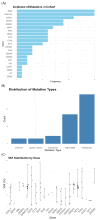Low WT1 Expression Identifies a Subset of Acute Myeloid Leukemia with a Distinct Genotype
- PMID: 40227798
- PMCID: PMC11988028
- DOI: 10.3390/cancers17071213
Low WT1 Expression Identifies a Subset of Acute Myeloid Leukemia with a Distinct Genotype
Abstract
Background: Wilms' tumor gene 1 (WT1) is a critical player in acute myeloid leukemia (AML), often serving as a biomarker for measurable residual disease (MRD). The WT1 gene is overexpressed in the majority of AML cases at diagnosis, with apparently no correlation with prognosis, and in the meantime, its role in patients with low-level expression is still undefined. This study investigates the mutational landscape and clinical outcomes of AML patients with low WT1 expression at diagnosis. Methods: We analyzed 34 AML patients with low WT1 expression (WT1/ABL1 < 250) diagnosed and treated from 2013 to 2017 at three institutions. Next-generation sequencing (NGS) was employed to investigate the mutational status of 32 genes commonly mutated in AML. The presence of specific mutations, as well as clinical outcomes, was compared to the general AML population. Results: Patients with low WT1 expression showed a significantly higher mutational burden, with a median of 3.4 mutations per patient, compared to the general AML population. Notably, clonal hematopoiesis (CHIP) or myelodysplasia-related (MR) mutations, particularly in ASXL1, TET2, and SRSF2, were present in most patients with low WT1 expression. All but one case of NPM1- or FLT3-mutant AML in the low-WT1 cohort harbored more CHIP or MR mutations. Patients with low WT1 expression had an overall survival (OS) that was superimposable to the OS expected in MR AML. Conclusions: Low WT1 expression in AML is associated with a distinct and complex mutational profile, marked by frequent CHIP and MR mutations.
Keywords: AML; CHIP mutations; WT1; low WT1 expression; marrow dysplasia; measurable residual disease; next-generation sequencing; prognosis.
Conflict of interest statement
M.R. was a consultant for or was included in the speakers bureau for Novartis, Gentili, Blueprint, and Jazz. G.M. received research funds from AbbVie, Astellas, AstraZeneca, Daiichi Sankyo, Pfizer, and Syros and was a consultant for or was included in the speakers bureau for AbbVie, Astellas, AstraZeneca, Immunogen, Janssen, Menarini/Stemline, Pfizer, Ryvu, Servier, Syros, and Takeda. F.L. received research funds from Pfizer and Alexion and is a consultant for Sobi, Roche, AbbVie, Amgen, and Novartis. The remaining authors declare that this research was conducted in the absence of any commercial or financial relationships that could be construed as potential conflicts of interest.
Figures
Similar articles
-
Wilms' tumor 1 gene mutations independently predict poor outcome in adults with cytogenetically normal acute myeloid leukemia: a cancer and leukemia group B study.J Clin Oncol. 2008 Oct 1;26(28):4595-602. doi: 10.1200/JCO.2007.15.2058. Epub 2008 Jun 16. J Clin Oncol. 2008. PMID: 18559874 Free PMC article.
-
The assessment of minimal residual disease versus that of somatic mutations for predicting the outcome of acute myeloid leukemia patients.Cancer Cell Int. 2019 Apr 4;19:83. doi: 10.1186/s12935-019-0807-0. eCollection 2019. Cancer Cell Int. 2019. PMID: 30992690 Free PMC article.
-
[Using next generation sequencing technology to analyze gene mutations in patients with acute myeloid leukemia and the impact on prognosis].Zhonghua Yi Xue Za Zhi. 2019 Oct 29;99(40):3145-3151. doi: 10.3760/cma.j.issn.0376-2491.2019.40.005. Zhonghua Yi Xue Za Zhi. 2019. PMID: 31694105 Chinese.
-
The Role of Wilms' Tumor Gene (WT1) Expression as a Marker of Minimal Residual Disease in Acute Myeloid Leukemia.J Clin Med. 2022 Jun 9;11(12):3306. doi: 10.3390/jcm11123306. J Clin Med. 2022. PMID: 35743376 Free PMC article. Review.
-
Minimal/Measurable Residual Disease Monitoring in NPM1-Mutated Acute Myeloid Leukemia: A Clinical Viewpoint and Perspectives.Int J Mol Sci. 2018 Nov 6;19(11):3492. doi: 10.3390/ijms19113492. Int J Mol Sci. 2018. PMID: 30404199 Free PMC article. Review.
Cited by
-
Acute Myeloid Leukemia: Updates on Diagnosis, Treatment and Management.Cancers (Basel). 2025 Jul 18;17(14):2387. doi: 10.3390/cancers17142387. Cancers (Basel). 2025. PMID: 40723269 Free PMC article.
References
-
- Barragán E., Cervera J., Bolufer P., Ballester S., Martín G., Fernández P., Collado R., Sayas M.J., Sanz M.A. Prognostic implications of Wilms’ tumor gene (WT1) expression in patients with de novo acute myeloid leukemia. Haematologica. 2004;89:926–933. - PubMed
-
- Lapillonne H., Renneville A., Auvrignon A., Flamant C., Blaise A., Perot C., Lai J.L., Ballerini P., Mazingue F., Fasola S., et al. High WT1 expression after induction therapy predicts high risk of relapse and death in pediatric acute myeloid leukemia. J. Clin. Oncol. 2006;24:1507–1515. doi: 10.1200/JCO.2005.03.5303. - DOI - PubMed
-
- Hämäläinen M.M., Kairisto V., Juvonen V., Johansson J., Aurén J., Kohonen K., Remes K., Salmi T.T., Helenius H., Pelliniemi T.T. Wilms tumour gene 1 overexpression in bone marrow as a marker for minimal residual disease in acute myeloid leukaemia. Eur. J. Haematol. 2008;80:201–207. doi: 10.1111/j.1600-0609.2007.01009.x. - DOI - PubMed
LinkOut - more resources
Full Text Sources
Miscellaneous



